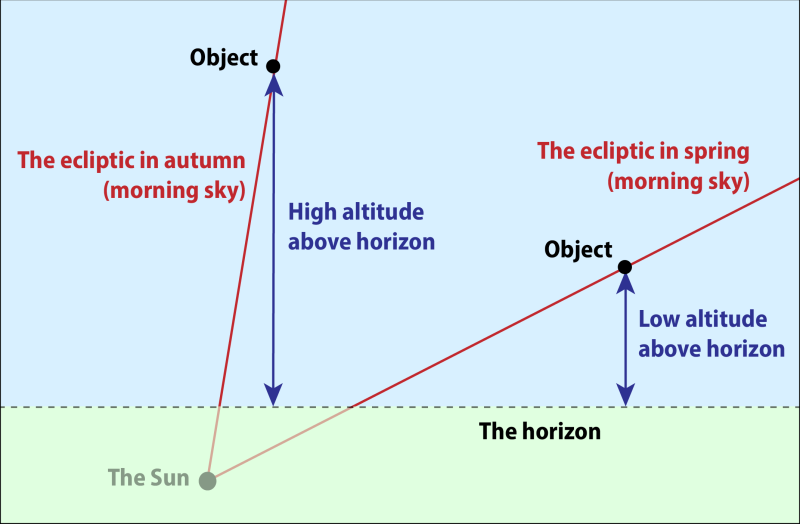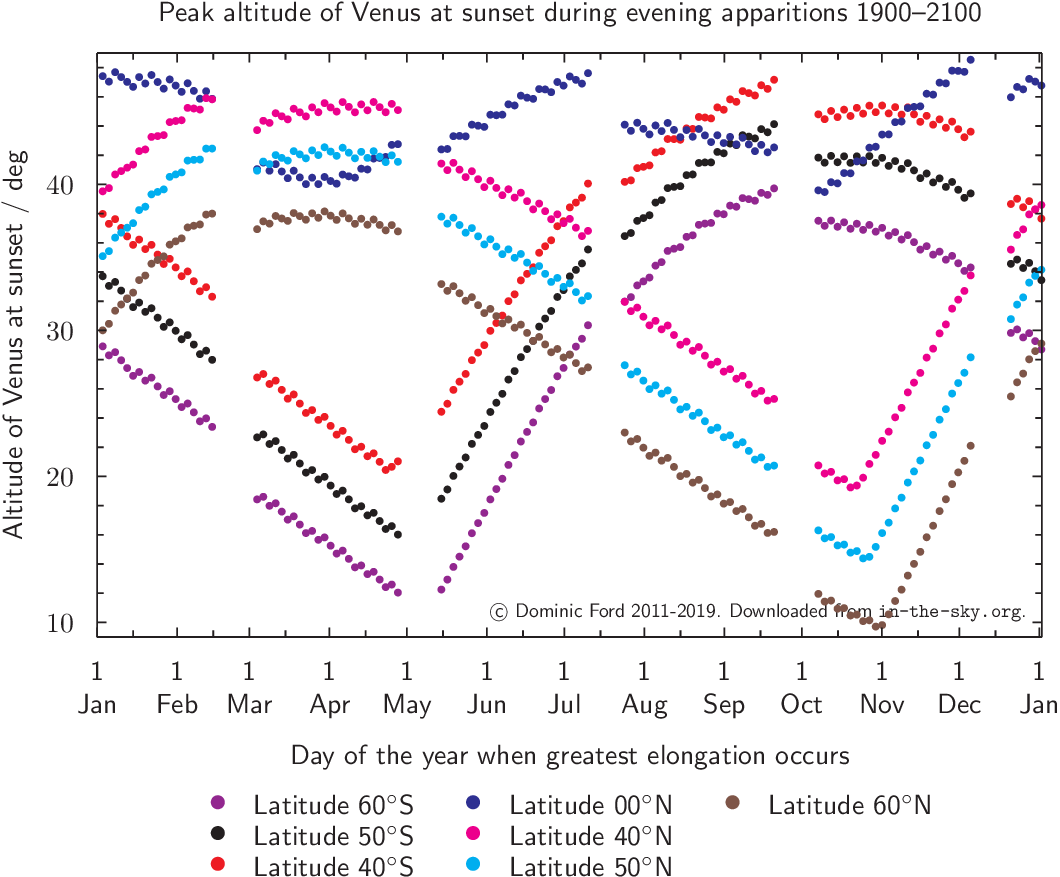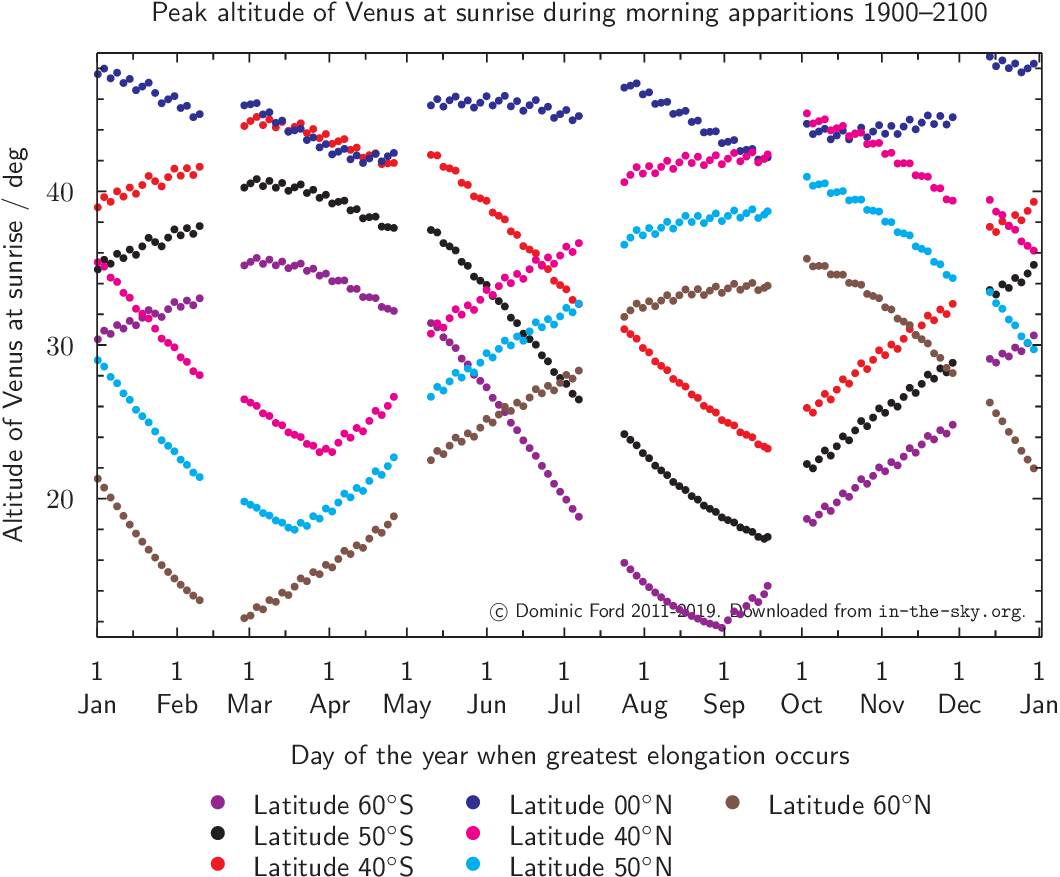Venus
The planets of the solar system:
Mercury
Venus
Earth
Mars
Jupiter
Saturn
Uranus
Neptune
Venus will soon pass behind the Sun. From South El Monte, it is not readily observable since it is very close to the Sun, at a separation of only 0° from it.
| 26 Jul 2025 | – Venus at highest altitude in morning sky |
| 12 Jun 2026 | – Venus at highest altitude in evening sky |
| 14 Aug 2026 | – Venus at greatest elongation east |
| 14 Dec 2026 | – Venus at highest altitude in morning sky |
The planet Venus, photographed by Ricardo Nunes.
Venus is the second planet from the Sun, orbiting at a distance of 0.723 AU once every 224 days.
It is our neighbour in the solar system, orbiting just inside the Earth's orbit. It is of a similar size to the Earth – around 95% of an Earth-width across – and has similar abundances of chemical elements such as carbon. For this reason, Venus is often considered to be the Earth's 'twin' planet.
Even though Venus orbits closer to the Sun than the Earth, its surface receives less heat from the Sun since it is permanently enshrouded by thick cloud layers. These reflect so much sunlight back into space that they more than compensate for the increased intensity of the Sun's light. They also make it virtually impossible to observe Venus's surface, meaning that the planet presents a bland and largely featureless disk.
Apparitions of Venus
The table below lists apparitions of Venus around the year 2026, computed from NASA's DE430 planetary ephemeris. To show events around other years, use the control below.
Apparitions of Venus around 2026
| Date | Event | Declination | Angular size |
| Date | Event | Declination | Angular size |
| 29 Oct 2021 07:57 PDT | Venus at greatest elongation east | 26°54'S | 24.9" |
| 20 Mar 2022 14:35 PDT | Venus at greatest elongation west | 14°53'S | 24.5" |
| 04 Jun 2023 09:11 PDT | Venus at greatest elongation east | 22°53'N | 23.6" |
| 23 Oct 2023 17:05 PDT | Venus at greatest elongation west | 6°19'N | 24.0" |
| 10 Jan 2025 00:31 PST | Venus at greatest elongation east | 9°28'S | 24.5" |
| 31 May 2025 13:57 PDT | Venus at greatest elongation west | 7°28'N | 23.9" |
| 14 Aug 2026 14:59 PDT | Venus at greatest elongation east | 4°16'S | 24.2" |
| 03 Jan 2027 10:21 PST | Venus at greatest elongation west | 15°56'S | 24.7" |
| 21 Mar 2028 14:51 PDT | Venus at greatest elongation east | 19°51'N | 23.4" |
| 10 Aug 2028 21:32 PDT | Venus at greatest elongation west | 20°05'N | 23.4" |
| 26 Oct 2029 21:02 PDT | Venus at greatest elongation east | 26°45'S | 24.9" |
| 18 Mar 2030 05:42 PDT | Venus at greatest elongation west | 15°26'S | 24.5" |
| 02 Jun 2031 01:22 PDT | Venus at greatest elongation east | 23°25'N | 23.6" |
Observing Venus
Because Venus's orbit lies closer to the Sun than the Earth's, it always appears close to the Sun and is lost in the Sun's glare much of the time.
It is observable for a few months each time it reaches greatest separation from the Sun – moments referred to as greatest elongation.
On these occasions, Venus is so bright and conspicuous that it becomes the third brightest object in the sky after the Sun and Moon. It is often called the morning star or the evening star.
These apparitions repeat roughly once every 1.6 years, taking place alternately in the morning and evening skies, depending whether Venus lies to the east of the Sun or to the west.
When it lies to the east, it rises and sets a short time after the Sun and is visible in early evening twilight. When it lies to the west of the Sun, it rises and sets a short time before the Sun and is visible shortly before sunrise.
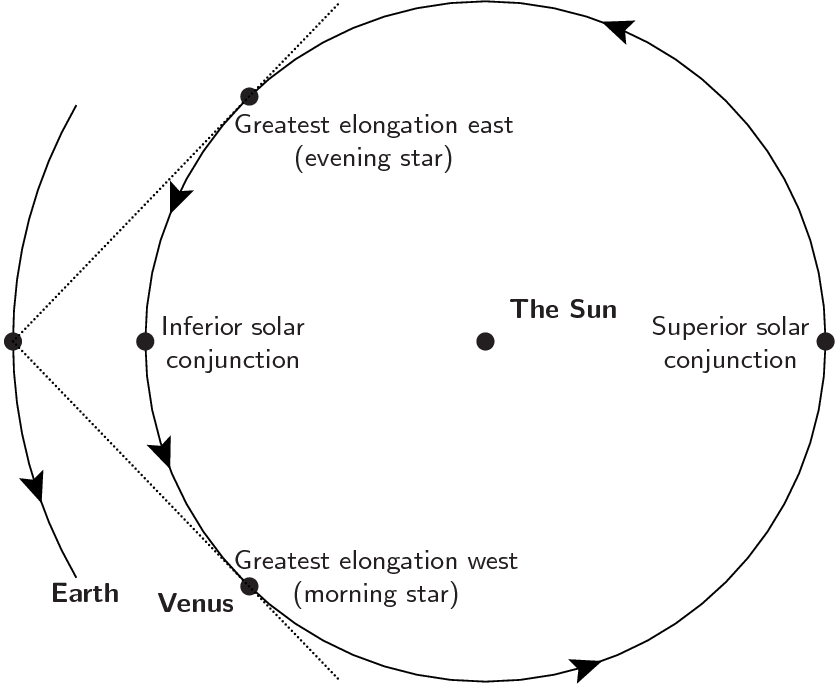
After passing behind the Sun, Venus first appears in the evening sky for a few months, lying to the east of the Sun. It then undergoes inferior solar conjunction, passing between the Earth and Sun a few months after reaching greatest prominence in the evening sky. Moving into the morning sky, it then reaches greatest prominence as the 'morning star' a few months later.
The reverse journey, from the morning sky into the evening sky, takes much longer, as Venus travels a long path around behind the Sun. The moment when Venus passes behind the Sun is typically around seven months after reaching greatest prominence in the morning sky. It does not return to the evening sky until around a year after its disappearance from the morning sky.
At each apparition, Venus reaches a maximum separation from the Sun of around 48°. However, some times of the year are more favourable for viewing Venus than others. From South El Monte, it reaches a peak altitude of between 22° and 47° above the horizon at sunset during each evening apparition, depending on the time of year. During morning apparitions, it reaches a peak altitude of between 26° and 47° at sunrise.
This variability over the course of the year is due to the inclination of the ecliptic to the horizon.
The inclination of the ecliptic to the horizon
At all times, Venus lies close to a line across the sky called the ecliptic. This line traces the path that the Sun takes through the zodiacal constellations every year, and shows the plane of the Earth's orbit around the Sun. Since all the planets circle the Sun in almost exactly the same plane, it also closely follows the planes of the orbits of the other planets, too.
When Venus is widely separated from the Sun, it is separated from it along the line of the ecliptic. But, at different times of year, the ecliptic meets the horizon at different angles at sunset and sunrise. This would translate into Venus being at different altitudes above the horizon, even if its separation from the Sun was constant.
If the ecliptic meets the horizon at a shallow angle, then Venus has to be very widely separated from the Sun to appear much above the horizon. Conversely, if the ecliptic is almost perpendicular to the horizon, Venus may appear much higher in the sky, even if it is actually much closer to the Sun.
The seasonal dependence of this is that at sunset, the ecliptic makes its steepest angle to the horizon at the spring equinox – in March in the northern hemisphere, and in September in the southern hemisphere. Conversely, it meets the horizon at its shallowest angle at the autumn equinox. Because the seasons are opposite in the northern and southern hemispheres, a good apparition of Venus in one hemisphere will usually be badly placed in the other.
At sunrise, these dates are also inverted, so that for morning apparitions of Venus, the ecliptic makes its steepest angle to the horizon at the autumn equinox, and its shallowest angle to the horizon at the spring equinox.
The optimum time for an apparition of Venus
For this reason, the day when Venus reaches its widest separation from the Sun (greatest elongation) is not necessarily the same day when it appears highest in the sky at sunset or sunrise. Venus typically appears highest in the sky a few days or weeks closer to the spring (evening apparitions) or autumn (morning apparitions) equinox than the moment of greatest elongation.
Visual appearance
Seen through binoculars or a telescope, Venus's disk is the largest of any of the planets on account of its closeness to the Earth, reaching a maximum size of 66" at inferior conjunction.
Nonetheless, it remains just too small to be discernible to the naked eye. Even through a telescope, it is not possible to resolve any detail on its surface without specialist equipment, owing to the thick featureless cloud layers which surround it.
However, as it orbits the Sun, Venus shows phases akin to those of the Moon, and these are quite apparent even through a pair of binoculars, especially if image stabilised.
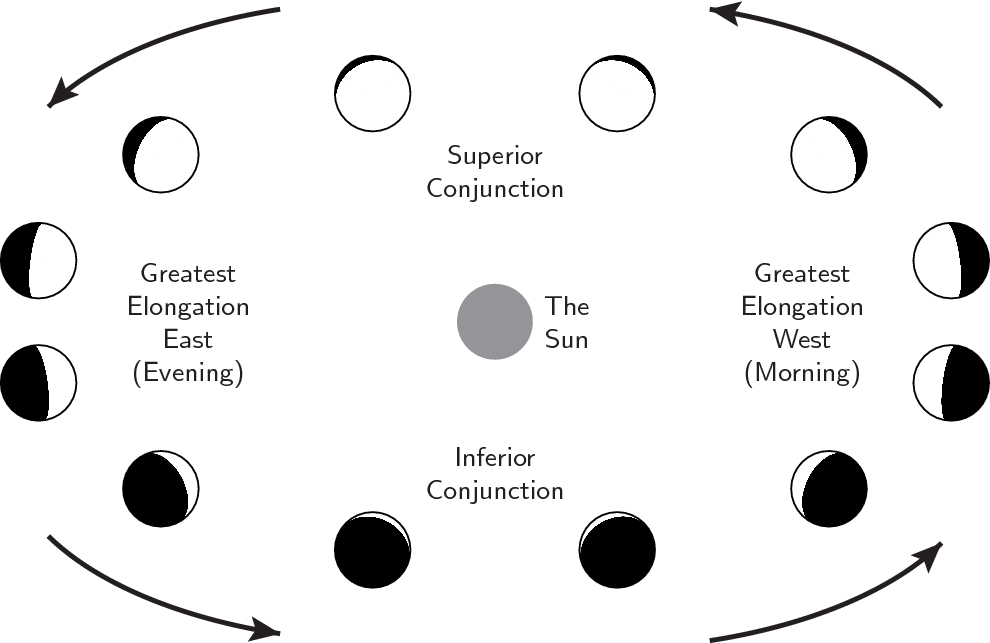
As it orbits the Sun, Venus shows phases like the Moon. When it is closest to the Earth, passing between us and the Sun, Venus appears almost entirely unilluminated. When it passes around the far side of the Sun, its disk appears almost completely illuminated. When it is prominent in the morning or evening sky, Venus is around half phase.
Space missions
Venus was the first planet ever to be visited by a space probe. After a failed Soviet attempt, the first spacecraft to successfully fly past Venus was the American Mariner 2 (1962).
It has since been visited by more than 20 spacecraft, most recently the American Magellan (1989) and European Venus Express (2005).
These have revealed that the planet's surface temperature to be 480°C – the highest average surface temperature of any body in the Solar System, and hot enough to melt lead and to visibly glow red hot. Its atmosphere has been found to be composed primarily of carbon dioxide, with traces of other noxious compounds such as sulphuric acid, which gives its clouds an acidic yellow hue.
These extreme climatic conditions are less a result of Venus's proximity to the Sun, and more a result of the greenhouse effect: Venus has the strongest known greenhouse effect of any body in the Solar System. Current thinking is that the Earth and Venus may have been very similar planets at the time of their formation, but that a point of divergence came early in their history, when oceans formed on the Earth, allowing carbon dioxide to dissolve in the water and become locked up in carbonaceous rocks such as limestone (calcium carbonate). On Venus, this process never happened, and most of its carbon remains in the form of carbon dioxide in its atmosphere.
| NORAD ID | COSPAR ID | Name | Launch date | Flight ended | Owner |
| NORAD ID | COSPAR ID | Name | Launch date | Flight ended | Owner |
| 71 | 1961-002A | SPUTNIK 7 | 04 Feb 1961 | 26 Feb 1961 | Commonwealth of Independent States (former USSR) |
| 80 | 1961-003A | VENERA 1 | 12 Feb 1961 | Commonwealth of Independent States (former USSR) | |
| 371 | 1962-040A | SPUTNIK 19 | 24 Aug 1962 | 27 Aug 1962 | Commonwealth of Independent States (former USSR) |
| 374 | 1962-041A | MARINER 2 | 26 Aug 1962 | United States | |
| 381 | 1962-043A | SPUTNIK 20 | 31 Aug 1962 | 05 Sep 1962 | Commonwealth of Independent States (former USSR) |
| 389 | 1962-045A | SPUTNIK 21 | 11 Sep 1962 | 13 Sep 1962 | Commonwealth of Independent States (former USSR) |
| 687 | 1963-044A | COSMOS 21 | 11 Nov 1963 | 14 Nov 1963 | Commonwealth of Independent States (former USSR) |
| 772 | 1964-014A | COSMOS 27 | 26 Mar 1964 | 28 Mar 1964 | Commonwealth of Independent States (former USSR) |
| 785 | 1964-016D | ZOND 1 | 01 Apr 1964 | Commonwealth of Independent States (former USSR) | |
| 1730 | 1965-091A | VENERA 2 | 12 Nov 1965 | Commonwealth of Independent States (former USSR) | |
| 1742 | 1965-094A | COSMOS 96 | 23 Nov 1965 | 09 Dec 1965 | Commonwealth of Independent States (former USSR) |
| 2845 | 1967-060A | MARINER 5 | 13 Jun 1967 | United States | |
| 2852 | 1967-063A | COSMOS 167 | 16 Jun 1967 | 24 Jun 1967 | Commonwealth of Independent States (former USSR) |
| 4501 | 1970-065A | COSMOS 359 | 21 Aug 1970 | 05 Nov 1970 | Commonwealth of Independent States (former USSR) |
| 5919 | 1972-023A | COSMOS 482 | 30 Mar 1972 | 04 May 1981 | Commonwealth of Independent States (former USSR) |
| 6919 | 1973-085A | MARINER 10 | 03 Nov 1973 | United States | |
| 20298 | 1989-084B | GALILEO | 17 Oct 1989 | 20 Sep 2003 | United States |
| 25008 | 1997-061A | CASSINI | 14 Oct 1997 | 14 Sep 2017 | United States |
| 28391 | 2004-030A | MESSENGER | 02 Aug 2004 | 29 Apr 2015 | United States |
| 36576 | 2010-020D | AKATSUKI | 19 May 2010 | Japan |
Warning
Never attempt to view Venus through a telescope or binoculars if the Sun is still above the horizon. A momentary glance at the Sun through such an instrument is sufficient to cause permanent blindness.
